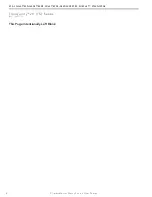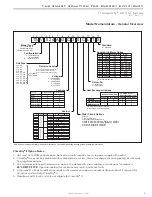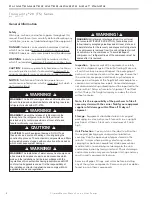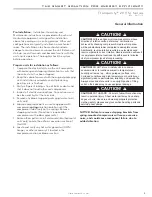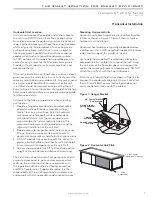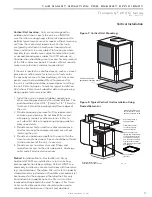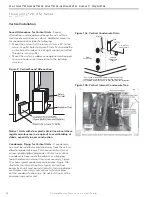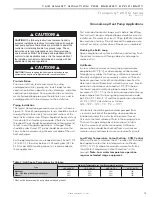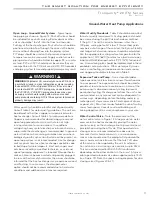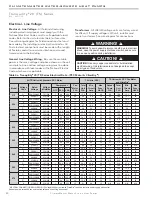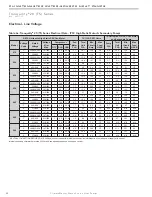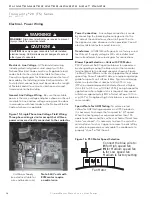
13
c l i m a t e m a s t e r. c o m
T H E S M A R T S O L U T I O N F O R E N E R G Y E F F I C I E N C Y
Tr a n q u i l i t y
®
2 0 ( T S ) S e r i e s
R e v. : 0 6 / 1 7 / 1 5
Piping Installation
CAUTION!
Corrosive system water requires corrosion
resistant fi ttings and hoses, and may require water treatment.
Table 1: Metal Hose Minimum Bend Radii
Hose Diameter
Minimum Bend Radii
1/2" [12.7mm]
2-1/2" [6.4cm]
3/4" [19.1mm]
4" [10.2cm]
1" [25.4mm]
5-1/2" [14cm]
1-1/4" [31.8mm]
6-3/4" [17.1cm]
CAUTION!
Do not bend or kink supply lines or hoses.
NOTICE! Do not allow hoses to rest against structural
building components. Compressor vibration may
be transmitted through the hoses to the structure,
causing unnecessary noise complaints.
Figure 11: Supply/Return Hose Kit
CAUTION!
CAUTION!
CAUTION!
Rib Crimped
Length
(2 ft [0.6m] Length Standard)
Swivel
Brass
Fitting
Brass
Fitting
MPT
MPT
CAUTION!
Piping must comply with all applicable codes.
Installation of Supply and Return Piping
Follow these piping guidelines.
1. Install a drain valve at the base of each supply and
return riser to facilitate system fl ushing.
2. Install shut-off / balancing valves and unions at each
unit to permit unit removal for servicing.
3. Place strainers at the inlet of each system circulating
pump.
4. Select the proper hose length to allow slack between
connection points. Hoses may vary in length by +2%
to -4% under pressure.
5. Refer to Table 1. Do not exceed the minimum bend
radius for the hose selected. Exceeding the minimum
bend radius may cause the hose to collapse, which
reduces water fl ow rate. Install an angle adapter to
avoid sharp bends in the hose when the radius falls
below the required minimum.
Insulation is not required on loop water piping except
where the piping runs through unheated areas, outside
the building or when the loop water temperature is
below the minimum expected dew point of the pipe
ambient conditions. Insulation is required if loop water
temperature drops below the dew point (insulation is
required for ground loop applications in most climates).
Pipe joint compound is not necessary when Tefl on
®
thread tape is pre-applied to hose assemblies or when
fl ared-end connections are used. If pipe joint compound
is preferred, use compound only in small amounts on
the external pipe threads of the fi tting adapters. Prevent
sealant from reaching the fl ared surfaces of the joint.
Note: When antifreeze is used in the loop, ensure that
it is compatible with the Tefl on
®
tape or pipe joint
compound that is applied.
Maximum allowable torque for brass fi ttings is 30 ft-lbs
[41 N-m]. If a torque wrench is not available, tighten
fi nger-tight plus one quarter turn. Tighten steel fi ttings
as necessary.
Optional pressure-rated hose assemblies designed
specifi cally for use with ClimateMaster units are available.
Similar hoses can be obtained from alternate suppliers.
Supply and return hoses are fi tted with swivel-joint fi ttings
at one end to prevent kinking during installation.
Refer to Figure 11 for an illustration of a typical supply/
return hose kit. Adapters secure hose assemblies to the
unit and risers. Install hose assemblies properly and check
regularly to avoid system failure and reduced service life.
Installer Caution:
After making water connections on
units equipped with ClimaDry
®
, ensure the three union
nuts on the internal three-way water valve are tight.
ClimaDry
®
-equipped units have a manual air bleed valve
at the top of the reheat coil. This valve must be used to
bleed the air from the reheat coil after fi lling the system,
for the ClimaDry
®
to operate properly.
WARNING!
Polyolester Oil, commonly known as POE oil, is
a synthetic oil used in many refrigeration systems including
those with HFC-410A refrigerant. POE oil, if it ever comes
in contact with PVC or CPVC piping, may cause failure of
the PVC/CPVC. PVC/CPVC piping should never be used
as supply or return water piping with water source heat
pump products containing HFC-410A as system failures and
property damage may result.
WARNING!


